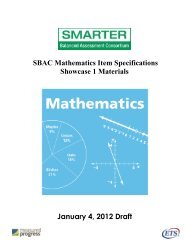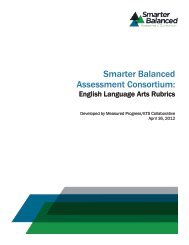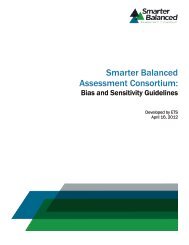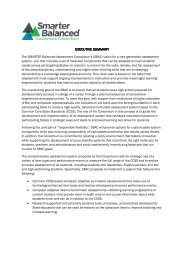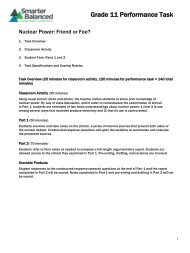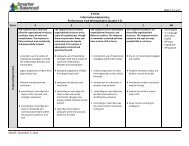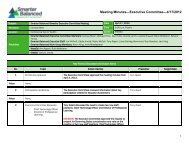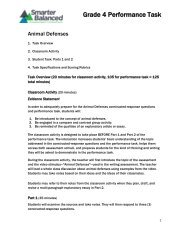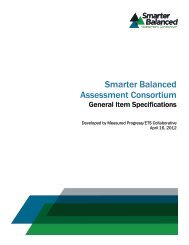Content Specifications for the Summative Assessment of the ...
Content Specifications for the Summative Assessment of the ...
Content Specifications for the Summative Assessment of the ...
You also want an ePaper? Increase the reach of your titles
YUMPU automatically turns print PDFs into web optimized ePapers that Google loves.
Some assessment items/tasks will focus on reading one text, while o<strong>the</strong>rs will require students to<br />
compare, analyze, or integrate in<strong>for</strong>mation from more than one text. Consistent with CCSS and <strong>the</strong><br />
National <strong>Assessment</strong> <strong>of</strong> Educational Progress (NAEP) recommendations, at grades 3-5, equal<br />
assessment emphasis will be placed on reading both literary and in<strong>for</strong>mational texts. At grades 6-8,<br />
assessment emphasis will shift to slightly more on in<strong>for</strong>mational texts (55%) than on literary texts<br />
(45%). By high school, greater emphasis (70%) will placed on reading a range <strong>of</strong> in<strong>for</strong>mational texts,<br />
including literary nonfiction. Texts chosen <strong>for</strong> assessment will represent a variety <strong>of</strong> genres and <strong>for</strong>mats<br />
<strong>for</strong> literary and in<strong>for</strong>mational texts. General guidelines will be developed during <strong>the</strong> test development<br />
phase regarding text selection <strong>for</strong> <strong>the</strong> reading assessment items and tasks at each grade span.<br />
Accessibility & Claim #1: This claim clarifies <strong>the</strong> importance <strong>of</strong> comprehending both literary/narrative<br />
and in<strong>for</strong>mational/expository texts. It does not explicitly address <strong>the</strong> challenges that many students with<br />
disabilities face in <strong>the</strong> areas <strong>of</strong> decoding and fluency. In contrast to a view where decoding and fluency<br />
are gateways to comprehension, many successful adults with disabilities use alternative means <strong>of</strong> access<br />
to text (including assistive technologies, such as text to speech) to bypass <strong>the</strong> need <strong>for</strong> decoding and<br />
fluency when <strong>the</strong>y comprehend and think critically about text. These individuals (Reitz, 2011)<br />
demonstrate high levels <strong>of</strong> success working with both literary and in<strong>for</strong>mational texts. Because <strong>of</strong> <strong>the</strong><br />
importance <strong>of</strong> building skills in decoding and fluency in early schooling, <strong>the</strong> explication <strong>of</strong> <strong>the</strong> content<br />
may be different in early school grades compared to later school grades. Thus, providing assistive<br />
technologies such as speech to text may not be considered appropriate up through an intermediate-level<br />
grade, say, 4 or 5. After that, <strong>the</strong> use <strong>of</strong> speech to text (or a human reader) is considered an appropriate<br />
avenue <strong>of</strong> access to allow students to demonstrate that <strong>the</strong>y are able to “read closely and critically to<br />
comprehend a range <strong>of</strong> increasingly complex literary and in<strong>for</strong>mational texts.” This approach is<br />
consistent with <strong>the</strong> CCSS document, which states that “<strong>for</strong> students with disabilities reading should<br />
allow <strong>for</strong> <strong>the</strong> use <strong>of</strong> Braille, screen reader technology, or assistive devices…” (p. 6).<br />
With respect to English learners and o<strong>the</strong>r test takers, it will be important to ensure that test items are<br />
measuring students’ mastery <strong>of</strong> <strong>the</strong> intended knowledge and skills, uncontaminated by irrelevant factors,<br />
such as language complexity unrelated to <strong>the</strong> focal construct being measured or language idioms or<br />
cultural referents that may be obscure to new immigrants. Fur<strong>the</strong>r, based on English language<br />
pr<strong>of</strong>iciency, it will important to provide access <strong>for</strong> ELL students to items / tasks that are linguistically<br />
accessible in all content areas, including English Language Arts & Literacy in History/Social Studies,<br />
Science, and Technical Subjects, without altering <strong>the</strong> focal constructs.<br />
About <strong>the</strong> “<strong>Summative</strong> <strong>Assessment</strong> Targets” that follow…<br />
The following pages identify summative assessment targets that describe <strong>the</strong> evidence that will be used to support Claim<br />
#1. <strong>Summative</strong> assessment targets do not replace <strong>the</strong> Common Core standards; ra<strong>the</strong>r, <strong>the</strong>y reference specific standards at<br />
each grade level that test developers will use to guide item and task development and collectively serve <strong>the</strong> purpose <strong>of</strong><br />
providing a consistent sampling plan <strong>for</strong> assessment within and across grades. All assessment targets will have some test<br />
items, as determined by <strong>the</strong> test blueprints.<br />
The targets that are provided are <strong>for</strong> grades 4, 8, and 11, serving as elementary, middle, and high school examples <strong>of</strong> <strong>the</strong><br />
targets that <strong>the</strong> Consortium will develop <strong>for</strong> grades 3-11. The summative assessment targets at each grade level represent <strong>the</strong><br />
prioritized content <strong>for</strong> assessment. Each assessment target is accompanied by <strong>the</strong> related standard(s) in <strong>the</strong> CCSS from which<br />
it is drawn, and by <strong>the</strong> intended cognitive rigor/depth-<strong>of</strong>-knowledge (DOK) required by <strong>the</strong> assessment target.<br />
Anchor Standard 1 in reading (and each grade specific version <strong>of</strong> this standard) underlies Reading Standards 2-9. It focuses<br />
on students’ use <strong>of</strong> evidence to support <strong>the</strong>ir analyses (claims, conclusions, inferences) about texts. Hence, whe<strong>the</strong>r students<br />
30



